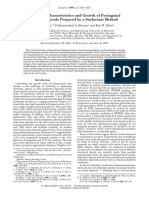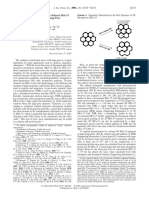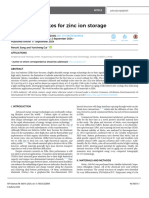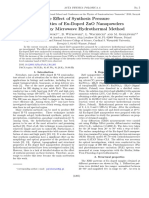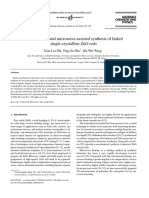Large-Scale Synthesis of High-Quality Ultralong Copper Nanowires
Large-Scale Synthesis of High-Quality Ultralong Copper Nanowires
Uploaded by
orang_udikCopyright:
Available Formats
Large-Scale Synthesis of High-Quality Ultralong Copper Nanowires
Large-Scale Synthesis of High-Quality Ultralong Copper Nanowires
Uploaded by
orang_udikOriginal Title
Copyright
Available Formats
Share this document
Did you find this document useful?
Is this content inappropriate?
Copyright:
Available Formats
Large-Scale Synthesis of High-Quality Ultralong Copper Nanowires
Large-Scale Synthesis of High-Quality Ultralong Copper Nanowires
Uploaded by
orang_udikCopyright:
Available Formats
3746 Langmuir 2005, 21, 3746-3748
Large-Scale Synthesis of High-Quality Ultralong Copper
Nanowires
Yu Chang, Mei Ling Lye, and Hua Chun Zeng*
Department of Chemical and Biomolecular Engineering, Faculty of Engineering,
National University of Singapore, 10 Kent Ridge Crescent, Singapore 119260
Received January 25, 2005. In Final Form: March 11, 2005
The present difficulties in synthesis of one-dimensional copper are short length, nonlinear morphology,
polydispersivity, poor crystallinity, low yield, and process complexity. In this work, we demonstrate that
high-quality ultralong copper nanowires (90-120 nm in diameter, 40-50 µm in length; aspect ratio
>350-450) can be synthesized in large scale with a facile aqueous reduction route at low cost. The prepared
copper nanowires can also be used as starting solid precursor for fabrication of polycrystalline oxide nanotubes
via direct oxidation in air.
Copper is one of the most important metals in modern can be synthesized in large scale with a facile aqueous
technologies.1,2 For future bottom-up nanotechnology reduction route at low temperatures.
(e.g., nano-optoelectronic industry), as a first step, fab- In each synthesis, 20-30 mL of NaOH (3.5-15 M) and
rication of one-dimensional (1D) nanomaterials of copper 0.5-1.0 mL of Cu(NO3)2 (0.10 M) aqueous solution were
(wires/cables/rods) has received considerable attention in added to a glass reactor (capacity 50 mL). Varying amounts
recent years, and a number of methods have been of ethylenediamine (EDA; 0.050-2.0 mL; 99 wt %) and
available, which include electrochemical reactions,3-8 hydrazine (0.020-1.0 mL; 35 wt %) were also added
vapor depositions,9,10 soft and hard template processes,11-13 sequentially, followed by a thorough mixing of all reagents.
reverse micellar systems,14-17 etc.18,19 Although the sig- The reactor was then placed in a water bath with
nificant research endeavor has been devoted, there is still temperature control over 25-100 °C (optimized at 60 °C)
lack of effective methods for large-scale production of high- for 15 min to 15 h; copper products were washed and
quality nanostructured copper, or metal nanowires in harvested with centrifugation-redispersion cycles and
general, with precise morphological control. Major syn- stored in a water-hydrazine solution to prevent oxidation.
thetic difficulties encountered in this area are short length, Further details on the synthesis can be found in Sup-
nonlinear morphology, polydispersivity, poor crystallinity, porting Information (SI-1). The crystallographic structure
low yield, and process complexity.3-19 Herein, we dem- of products was determined with X-ray diffraction (XRD;
onstrate for the first time that high-quality ultralong Shimadzu XRD-6000, Cu KR). The spatial, morphological,
copper nanowires (all free-standing: 90-120 nm in and compositional investigations were carried out with
diameter, 40-50 µm in length; aspect ratio >350-450) scanning electron microscopy and energy-dispersive X-ray
spectroscopy (SEM/EDX; JSM-5600LV), field-emission
SEM (FESEM/EDX; JSM-6700F), transmission electron
(1) Joseph, G. Copper: Its Trade, Manufacture, Use, and Environ-
mental Status; ASM International: Materials Park, OH, 1999; pp 331- microscopy and selected area electron diffraction (TEM/
371. SAED; JEM-2010F), high-resolution TEM (HRTEM/EDX;
(2) Yong, C.; Zhang, B. C.; Seet, C. S.; See, A.; Chan, L.; Sudijono, JEM 3010, 300 kV), and X-ray photoelectron spectroscopy
J.; Liew, S. L.; Tung, C.-H.; Zeng, H. C. J. Phys. Chem. B 2002, 106, (XPS; AXIS-HSi, Kratos Analytical).20
12366-12368.
(3) Molares, M. E. T.; Buschmann, V.; Dobrev, D.; Neumann, R.; The formation of metallic copper in this work is based
Scholz, R.; Schuchert, I. U.; Vetter, J. Adv. Mater. 2001, 13, 62-65. on the following redox reaction under the basic condition.
(4) Gao, T.; Meng, G.; Wang, Y.; Sun, S.; Zhang, L. J. Phys.: Condens.
Matter 2002, 14, 355-363.
(5) Gillingham, D. M.; Müller, C.; Bland, J. A. C. J. Phys.: Condens. 2Cu2+ + N2H4 + 4OH- f 2Cu + N2 + 4H2O (1)
Matter 2003, 15, L291-L296.
(6) Pang, Y. T.; Meng, G. W.; Zhang, Y.; Fang, Q.; Zhang, L. D. Appl.
Phys. A 2003, 76, 533-536.
(7) Konishi, Y.; Motoyama, M.; Matsushima, H.; Fukunaka, Y.; Ishii, Figure 1 shows some FESEM and TEM images of copper
R.; Ito, Y. J. Electroanal. Chem. 2003, 559, 149-153. nanowires. The reductive conversion of Cu2+ to metallic
(8) Choi, H.; Park, S.-H. J. Am. Chem. Soc. 2004, 126, 6248-6249. copper in this process is 100%, which was indicated in
(9) Liu, Z.; Bando, Y. Adv. Mater. 2003, 15, 303-305. total disappearance of the light blue color (Cu2+; Sup-
(10) Liu, Z.; Bando, Y. Chem. Phys. Lett. 2003, 378, 85-88.
(11) Monson, C. F.; Woolley, A. T. Nano Lett. 2003, 3, 359-363. porting Information (SI)-1). Interestingly, the as-prepared
(12) Liu, Z.; Yang, Y.; Liang, J.; Hu, Z.; Li, S.; Peng, S.; Qian, Y. J. nanowire cake is lifted up to the top of solution (Figure
Phys. Chem. B 2003, 107, 12658-12661. 1A) due to the high density of solution and entrapping of
(13) Yen, M.-Y.; Chiu, C.-W.; Hsia, C.-H.; Chen, F.-R.; Kai, J.-J.; Lee,
C.-Y.; Chiu, H.-T. Adv. Mater. 2003, 15, 235-237. nitrogen bubbles (eq 1) among the nanowires after
(14) Pileni, M. P.; Gulik-Krzywicki, T.; Tanori, J.; Filankembo, A.; magnetic stirring. As shown in these images, the prepared
Dedieu, J. C. Langmuir 1998, 14, 7359-7363. nanowires are straight (Figure 1B,C), with constant
(15) Lisiecki, I.; Sack-Kongehl, H.; Weiss, K.; Urban, J.; Pileni, M.-P. diameters in the range of 60-160 nm (mostly in 90-
Langmuir 2000, 16, 8802-8806.
(16) Lisiecki, I.; Sack-Kongehl, H.; Weiss, K.; Urban, J.; Pileni, M.-P. 120 nm). The wires are ultralong, having lengths of more
Langmuir 2000, 16, 8807-8808. than 40 µm, which virtually corresponds to an aspect ratio
(17) Lisiecki, I.; Filankembo, A.; Sack-Kongehl, H.; Weiss, K.; Pileni, of greater than 350!
M.-P.; Urban, J. Phys. Rev. B 2000, 61, 4968.
(18) Li, Q.; Wang, C. Chem. Phys. Lett. 2003, 375, 525-531.
(19) Wang, Z. L.; Kong, X. Y.; Wen, X.; Yang, S. J. Phys. Chem. B (20) Lou, X. W.; Zeng, H. C. J. Am. Chem. Soc. 2003, 125, 2697-
2003, 107, 8275-8280. 2704.
10.1021/la050220w CCC: $30.25 © 2005 American Chemical Society
Published on Web 03/29/2005
Letters Langmuir, Vol. 21, No. 9, 2005 3747
Figure 1. (A) As-prepared Cu nanowires in mother liquor. (B, C) FESEM images of general and detailed views of Cu nanowires.
(D) TEM image of Cu nanowires.
each case, furthermore, there is an optimal molar ratio
between the two chemicals. With a moderate amount of
EDA, both wire- and disklike morphologies could be
obtained. When EDA was overused, however, the axial
1D growth of nanowires could be switched totally to a
radial expansion (i.e., a 2D growth). Figure 3 reports XRD
patterns and a disklike morphology of Cu at 100%
morphological yield under such a condition (SI-5). The
single-crystal disks also have 〈110〉 orientations, as
determined by the SAED method (Figure 3B). Quite
commonly, a seed area (holelike) in the center of the disk
can be identified, revealing the above 2D growth mech-
anism. The observed growth preference can be attributed
to steric hindrance and charge restriction of copper
complexes in the starting solution, such as [Cu(OH)4]2-,
[Cu(EDA)(OH)2], and [Cu(EDA)2]2+ etc.,21 on a growing
crystal plane, and to synergetic effects of ligand (EDA)
and electrolyte (NaOH) on adsorption and deactivation of
the grown part of a product morphology.
X-ray photoelectron spectroscopy (XPS) results for our
air-dried Cu nanowires are reported in Figure 4A. Cuprite
Cu2O (about 54% among total surface copper) was found
Figure 2. (A) HRTEM image of a Cu nanowire. (B) Location on the wire surfaces, on the basis of an analysis for the
of examined area (indicated with a frame) in (A). (C) A bead-
line model of the Cu (110) surface. (D) SAED pattern of a Cu
binding energies of Cu 2p3/2 (932.4 eV for Cu0 and
nanowire (inset). 932.2 eV for Cu+; reference C 1s was set at 284.7 eV;
SI-6)22 and O 1s (530.2 eV for the anion O2- in the cuprite)23
photoelectrons and the HRTEM image of Figure 2B in
The nanowires obtained are single crystalline with high
which a rough surface region of Cu nanowires can be seen.
lattice perfection (e.g., the lattice fringe d111 ) 2.10 (
Nonetheless, this surface oxidation can be prevented by
0.05 Å), as shown in Figure 2A and B. The growth direction
storing the nanowires in dilute hydrazine solution. Apart
of these wires is along the 〈110〉 (Figure 2C), on the basis
from their electric conductor applications, the copper
of selected area electron diffraction (SAED) analysis
nanowires prepared can also be used as a solid precursor
(Figure 2D; also SI-2). Our XRD study shows that all the
for fabrication of other nanostructures. As exampled in
prepared copper samples have a face-centered cubic (fcc)
panels B and C of Figure 4, straight polycrystalline CuO
structure (SG: Fm3 h m; JCPDS card no. 03-1005), and the
nanotubes, which retain the original shape of Cu nano-
lattice constant of this cubic phase ao is equal to 3.615 Å
wires, have been fabricated from direct metal oxidation.
(SI-3). The chemical composition of the nanowires was
A significant fraction of pristine Cu could be converted to
further confirmed with EDX spectroscopy technique
CuO after heating in air at 300 °C in just 10 min (SI-7).
(SI-4).
It is thought that the preformed surface Cu2O may provide
Our experiments (SI-1) indicate that a high concentra-
good starting points for metal out-diffusion, during which
tion of NaOH is essential to prevent the copper ions from
copper moves preferentially toward the surface region
forming copper hydroxide precipitates. On the other hand,
while oxygen anions on the surface are relatively immobile.
a certain amount of EDA is also indispensable to control
The hollowing mechanism of copper can also be explained
product morphology. The interplay between NaOH and
EDA had been recognized in this work. For example, with (21) Cotton, F. A.; Wilkinson, G. Advanced Inorganic Chemistry, 4th
a high concentration of NaOH, the needed amount of EDA ed.; John Willey & Sons: New York, 1980; Chapter 21, pp 689-821.
is small, while for a lower concentration of NaOH, the (22) Espinós, J. P.; Morales, J.; Barranco, A.; Caballero, A.; Holgado,
J. P.; González-Elipe, A. R. J. Phys. Chem. B 2002, 106, 6921-6929.
amount of EDA has to be increased accordingly in order (23) McCafferty, E.; Wightman, J. P. Surf. Interface Anal. 1998, 26,
to obtain high regularity for the 1D product (SI-1). In 549-564.
3748 Langmuir, Vol. 21, No. 9, 2005 Letters
Figure 3. (A) XRD patterns of Cu nanowires and disks. (B) FESEM image of a large Cu disk; the white arrow indicates the seed
area in the center. Inset of (B) shows the [110] zone diffraction spots of a Cu disk.
Figure 4. (A) XPS spectra of O 1s and Cu 2p3/2 photoelectrons of air-dried Cu nanowires. (B) TEM image of polycrystalline CuO
nanotubes formed by oxidizing in air at 400 °C for 10 h. (C) SAED pattern of CuO nanotubes formed in air at 400 °C for 3 h
(not shown).
with the Kirkendall-type diffusion process.24 Taking Acknowledgment. The authors gratefully acknowl-
advantage of their interior space,24,25 the polycrystalline edge the financial support of the Ministry of Education,
CuO (a p-type semiconducting oxide) nanotubes may find Singapore.
new applications in photocatalytic reactions such as water
splitting with visible lights.
In summary, using low-cost starting chemicals, large- Supporting Information Available: Tables of ex-
scale synthesis of high-quality ultralong copper nanowires perimental conditions for selected samples and figures showing
can be achieved under mild conditions. The prepared the color changing point at 30-45 min, the [001] zone diffraction
copper nanowires can also be used as starting solid spots of Cu nanowires, XRD patterns of some selected copper
precursor for fabrication of polycrystalline oxide nanotubes metal products, an EXD spectrum of copper nanowires, FESEM
via direct oxidation in air. images of Cu disks, and surface analysis of air-dried copper
nanowires. This material is available free of charge via the
(24) Yin, Y.; Rioux, R. M.; Erdonmez, C. K.; Hughes, S.; Somorjai,
Internet at http://pubs.acs.org.
G. A.; Alivisatos, A. P. Science 2004, 304, 711-714.
(25) Liu, B.; Zeng, H. C. J. Am. Chem. Soc. 2004, 126, 8124-8125. LA050220W
You might also like
- For The Radial Power System Shown in Figure 1.17, ...Document6 pagesFor The Radial Power System Shown in Figure 1.17, ...Ayush Gupta 4-Year B.Tech. Electrical Engineering100% (1)
- WELL Building Standard V PDFDocument279 pagesWELL Building Standard V PDFNina Lukic100% (1)
- Accident InvestigationsDocument21 pagesAccident InvestigationsChandan KumarNo ratings yet
- 19 AgDocument4 pages19 AgDeepikaNo ratings yet
- Metal - SDocument6 pagesMetal - SAnonymous cgKtuWzNo ratings yet
- Mesotunnels On The Silica Wall of Ordered SBA-15 To Generate Three-Dimensional Large-Pore Mesoporous NetworksDocument2 pagesMesotunnels On The Silica Wall of Ordered SBA-15 To Generate Three-Dimensional Large-Pore Mesoporous NetworksAneesh KumarNo ratings yet
- Mo Se2 Nanoflakes For Zinc Ion StorageDocument6 pagesMo Se2 Nanoflakes For Zinc Ion StorageDante AlighieriNo ratings yet
- 【119】Microstructural evolution and nanostructure formation in copper during - - dynamic plastic deformation at cryogenic temperaturesDocument12 pages【119】Microstructural evolution and nanostructure formation in copper during - - dynamic plastic deformation at cryogenic temperatureshq GNo ratings yet
- Bakke 2010Document10 pagesBakke 2010Felipe Olivares CodoceoNo ratings yet
- Wang 2017Document5 pagesWang 2017Tahar BoudellaNo ratings yet
- One-Pot, High-Yield Synthesis of 5-Fold Twinned PD Nanowires and NanorodsDocument2 pagesOne-Pot, High-Yield Synthesis of 5-Fold Twinned PD Nanowires and NanorodsJosé Adriano SilvaNo ratings yet
- The Effect of Synthesis Pressure On Properties of Eu-Doped Zno Nanopowders Prepared by Microwave Hydrothermal MethodDocument4 pagesThe Effect of Synthesis Pressure On Properties of Eu-Doped Zno Nanopowders Prepared by Microwave Hydrothermal MethodJarosław KaszewskiNo ratings yet
- Studies of Structural, Optical, and Electrical Properties Associated With Defects in Sodium-Doped Copper Oxide (Cuo/Na) NanostructuresDocument18 pagesStudies of Structural, Optical, and Electrical Properties Associated With Defects in Sodium-Doped Copper Oxide (Cuo/Na) NanostructuresBilal JuttNo ratings yet
- Bishnu P. Khanal and Eugene R. Zubarev - Purification of High Aspect Ratio Gold Nanorods: Complete Removal of PlateletsDocument9 pagesBishnu P. Khanal and Eugene R. Zubarev - Purification of High Aspect Ratio Gold Nanorods: Complete Removal of PlateletsYlpkasoNo ratings yet
- Eur J Inorg Chem - 2010 - Duan - Synthesis and Characterization of Metallic Co With Different Hierarchical StructuresDocument6 pagesEur J Inorg Chem - 2010 - Duan - Synthesis and Characterization of Metallic Co With Different Hierarchical Structuresmahdi ghamsariNo ratings yet
- ZnF2 PbO TeO2 TiO2Document8 pagesZnF2 PbO TeO2 TiO2hanumatharao kNo ratings yet
- Pure ZnODocument7 pagesPure ZnOraminder131977No ratings yet
- Effect of Al Content On Electrical Conductivity and Transparency of P-Type Cu-Al-O Thin FilmDocument4 pagesEffect of Al Content On Electrical Conductivity and Transparency of P-Type Cu-Al-O Thin FilmWL JangNo ratings yet
- Investigation of Quantum Oscillations in ZnOCdO HeterostructureDocument7 pagesInvestigation of Quantum Oscillations in ZnOCdO HeterostructureMatheus SilvaNo ratings yet
- Shreya Peeyush Chapters PublishedDocument20 pagesShreya Peeyush Chapters PublishedAman RaiNo ratings yet
- Medha1Document9 pagesMedha1Aman RaiNo ratings yet
- M & M Microstructural and Chemical Characterization of Ordered Struc in Y Doped CeriaDocument11 pagesM & M Microstructural and Chemical Characterization of Ordered Struc in Y Doped Ceria운배손No ratings yet
- 2017-Chemistry - An Asian JournalDocument6 pages2017-Chemistry - An Asian JournalcallmelittlebrookNo ratings yet
- Investigations On The Role of Alkali To Obtain Modulated Defect Concentrations For Cu2O Thin FilmsDocument7 pagesInvestigations On The Role of Alkali To Obtain Modulated Defect Concentrations For Cu2O Thin FilmsmusonlyNo ratings yet
- Optical and Photochemical Properties of Nonstoichiometric Cadmium Sulfide Nanoparticles: Surface Modification With Copper (II) IonsDocument8 pagesOptical and Photochemical Properties of Nonstoichiometric Cadmium Sulfide Nanoparticles: Surface Modification With Copper (II) IonszahidNo ratings yet
- 1 s2.0 S0038092X22007691 MainDocument9 pages1 s2.0 S0038092X22007691 MainbudispacemanNo ratings yet
- Materials 10 00227Document11 pagesMaterials 10 00227GaganaNo ratings yet
- Low Temperature Synthesis and Growth MecDocument4 pagesLow Temperature Synthesis and Growth MecsahinmetuNo ratings yet
- Nanorods 2Document5 pagesNanorods 2Yash SharanNo ratings yet
- Nuclear Physics - D. C. TayalDocument4 pagesNuclear Physics - D. C. TayalSimi S.PNo ratings yet
- In Situ TEM Study of Oxygen Vacancy Ordering and Dislocation AnnihilationDocument9 pagesIn Situ TEM Study of Oxygen Vacancy Ordering and Dislocation Annihilation운배손No ratings yet
- Au-Hematita 2Document5 pagesAu-Hematita 2Mariana AlvarezNo ratings yet
- Saboor - Et - Al-2021-Journal - of - Materials - Science - Materials - in - ElectronicsDocument14 pagesSaboor - Et - Al-2021-Journal - of - Materials - Science - Materials - in - ElectronicsSayed abdul saboor MosamemNo ratings yet
- ES Energy Environ., Vol. 22, 2023 - CompressedDocument5 pagesES Energy Environ., Vol. 22, 2023 - CompressedmurthygvnlNo ratings yet
- Journal of Physics and Chemistry of Solids: SciencedirectDocument5 pagesJournal of Physics and Chemistry of Solids: SciencedirectAnonymous dAN4dPGNo ratings yet
- 395 SrivastavaSDocument10 pages395 SrivastavaSamir ijazNo ratings yet
- 3 - Operando Synchrotron Transmission Xray Microscopy Study On High Entropy Oxide Anodes For Lithium Ion BatteriesDocument8 pages3 - Operando Synchrotron Transmission Xray Microscopy Study On High Entropy Oxide Anodes For Lithium Ion Batterieskenny5350No ratings yet
- Structural, Magnetic and Dielectric Analysis of Higher Magnetic MN Doped ZN-CR Oxide NanoparticlesDocument10 pagesStructural, Magnetic and Dielectric Analysis of Higher Magnetic MN Doped ZN-CR Oxide NanoparticlesIJRASETPublicationsNo ratings yet
- Wen 2010Document4 pagesWen 2010HOD PhysicsNo ratings yet
- 1-s2.0-S0169433208013846-mainDocument5 pages1-s2.0-S0169433208013846-mainmaximecontreras2No ratings yet
- Vertical Growth of Zno Nanowires On C-Al O Substrate by Controlling Ramping Rate in A Vapor-Phase Epitaxy MethodDocument5 pagesVertical Growth of Zno Nanowires On C-Al O Substrate by Controlling Ramping Rate in A Vapor-Phase Epitaxy MethodRaj PrakashNo ratings yet
- 1 s2.0 S0008884620308814 MainDocument14 pages1 s2.0 S0008884620308814 Mainvbjunmk1234567No ratings yet
- Copper (II) - Oxide Nanostructures: Synthesis, Characterizations and Their Applications-ReviewDocument6 pagesCopper (II) - Oxide Nanostructures: Synthesis, Characterizations and Their Applications-ReviewMurat YilmazNo ratings yet
- Effects of Cobalt Doping On The Structural, Optical, and Electrical Properties of Sno Nanostructures Synthesized by Silar MethodDocument12 pagesEffects of Cobalt Doping On The Structural, Optical, and Electrical Properties of Sno Nanostructures Synthesized by Silar MethodAmrita PalaiNo ratings yet
- Conductometric Chemical Sensor Based On Individual Cuo NanowiresDocument7 pagesConductometric Chemical Sensor Based On Individual Cuo NanowiresmirelamanteamirelaNo ratings yet
- Mechanical Properties and Corrosion Behaviour of Nanostructured Cu-Rich Cuni Electrodeposited FilmsDocument15 pagesMechanical Properties and Corrosion Behaviour of Nanostructured Cu-Rich Cuni Electrodeposited FilmsThanh DinhNo ratings yet
- 1 s2.0 S0956566309005016 MainDocument7 pages1 s2.0 S0956566309005016 Mainanupama_rani_2No ratings yet
- Sn Nucleation and Growth From Sn II Dissolved in 2024 Transactions of NonfeDocument19 pagesSn Nucleation and Growth From Sn II Dissolved in 2024 Transactions of NonfeyunlongNo ratings yet
- Materials Science in Semiconductor ProcessingDocument8 pagesMaterials Science in Semiconductor ProcessingjacoboNo ratings yet
- Zinc SulfideDocument8 pagesZinc Sulfideantonio SilvaNo ratings yet
- 291 1161 1 PB PDFDocument6 pages291 1161 1 PB PDFBùi Thanh TùngNo ratings yet
- Bioresource Technology: Junyeong An, Bongkyu Kim, Jonghyeon Nam, How Yong NG, in Seop ChangDocument5 pagesBioresource Technology: Junyeong An, Bongkyu Kim, Jonghyeon Nam, How Yong NG, in Seop ChangAnonymous a6dqwz4Y7BNo ratings yet
- Epitaxial Electrodeposition of Copper (I) Oxide On Single-Crystal CopperDocument8 pagesEpitaxial Electrodeposition of Copper (I) Oxide On Single-Crystal CopperDragan SokolovskiNo ratings yet
- TMP E120Document5 pagesTMP E120FrontiersNo ratings yet
- Sonochemical and Microwave-Assisted Synthesis of Linked Single-Crystalline Zno RodsDocument6 pagesSonochemical and Microwave-Assisted Synthesis of Linked Single-Crystalline Zno RodssecateNo ratings yet
- Electrochemical Formation and Reduction of Copper Oxide NanostructuresDocument4 pagesElectrochemical Formation and Reduction of Copper Oxide NanostructuresEdgar Fabian Pinzon NietoNo ratings yet
- Icamme2017paper Template Samplev1Document6 pagesIcamme2017paper Template Samplev1alagar krishna kumarNo ratings yet
- Corrosion of Copper Electrode in Sodium Sulfide Solution: Journal of Saudi Chemical SocietyDocument7 pagesCorrosion of Copper Electrode in Sodium Sulfide Solution: Journal of Saudi Chemical SocietyFebri Ramdani NugrahaNo ratings yet
- Zno NanorodsDocument5 pagesZno NanorodsmirelamanteamirelaNo ratings yet
- 1 s2.0 S221171562300139X MainDocument8 pages1 s2.0 S221171562300139X MainFazal RehmanNo ratings yet
- Kumar StructuralDocument11 pagesKumar StructuralAbdul ZahirNo ratings yet
- Paper 1Document9 pagesPaper 1Cristian RozoNo ratings yet
- Surface Plasmon Enhanced, Coupled and Controlled FluorescenceFrom EverandSurface Plasmon Enhanced, Coupled and Controlled FluorescenceNo ratings yet
- Acsanm 1c00774Document14 pagesAcsanm 1c00774orang_udikNo ratings yet
- BM 0497769Document7 pagesBM 0497769orang_udikNo ratings yet
- Not TafelDocument19 pagesNot Tafelorang_udikNo ratings yet
- Nickel Catalyst For ElectroOxidationDocument10 pagesNickel Catalyst For ElectroOxidationorang_udikNo ratings yet
- Aptecs Seminar Schedule Ed 3 Dec 2011Document13 pagesAptecs Seminar Schedule Ed 3 Dec 2011orang_udikNo ratings yet
- List of Accepted Paper 3rd APTECS 2011 - 10 - Nop - 2011Document15 pagesList of Accepted Paper 3rd APTECS 2011 - 10 - Nop - 2011orang_udikNo ratings yet
- Jadwal Seminar Aptecs 6 Des 2011 Revisi - 2Document3 pagesJadwal Seminar Aptecs 6 Des 2011 Revisi - 2orang_udikNo ratings yet
- GDPHM 505Document19 pagesGDPHM 505s.uttam.kr40No ratings yet
- K.Anh - Upgrade 3 UNIT 4Document2 pagesK.Anh - Upgrade 3 UNIT 4HameeyNo ratings yet
- James Merrill 1Document2 pagesJames Merrill 1Mohamed SaadNo ratings yet
- Chapter 12 Solutions PDFDocument6 pagesChapter 12 Solutions PDFFikri AzimNo ratings yet
- 01-Context Sensitive Rock Slope Design SolutionsDocument121 pages01-Context Sensitive Rock Slope Design SolutionsSan AndradeNo ratings yet
- Skyfire AvenueDocument162 pagesSkyfire AvenueMegumiNo ratings yet
- Perry's Chemical Engineers' Handbook, 8th Edition 242Document1 pagePerry's Chemical Engineers' Handbook, 8th Edition 242Ooi Chia EnNo ratings yet
- Introduction DiagnotikDocument3 pagesIntroduction DiagnotikItha Hernita NoviantiNo ratings yet
- Injection Molding NotesDocument23 pagesInjection Molding NotesK_Amey50% (2)
- Lte Cpe: CP2600-OP, A10-BDocument3 pagesLte Cpe: CP2600-OP, A10-Bhrga hrgaNo ratings yet
- Goat DaysDocument8 pagesGoat DaysAnagha Shree SNo ratings yet
- Direction:: Write The Letter of The Correct Answer. Use CAPITAL LETTERS OnlyDocument7 pagesDirection:: Write The Letter of The Correct Answer. Use CAPITAL LETTERS OnlyDominic Dalton CalingNo ratings yet
- Linear Seating Arrangement Questions For IBPS PO PDFDocument9 pagesLinear Seating Arrangement Questions For IBPS PO PDFPRABHAT JHANo ratings yet
- Chemistry in Everyday LifeDocument7 pagesChemistry in Everyday LifeDHARANEESH E 11BNo ratings yet
- PSP987W, Bulu Barumun, RBS6601 DUW30 RRUS2100 EnclDocument2 pagesPSP987W, Bulu Barumun, RBS6601 DUW30 RRUS2100 EnclOkas PaskalNo ratings yet
- Select Model:: SB20-03 SB20-01 Index CSB19-06Document5 pagesSelect Model:: SB20-03 SB20-01 Index CSB19-06Teo DazaNo ratings yet
- Helminthes: / Medical Laboratory TechnologyDocument17 pagesHelminthes: / Medical Laboratory Technologyصفا رياض محمد /مسائيNo ratings yet
- 2222222222Document6 pages2222222222APEX SONNo ratings yet
- Aahar 2011Document66 pagesAahar 2011Ashish Angelz ExhibitionsNo ratings yet
- Sensus WP Dynamic KatalogDocument4 pagesSensus WP Dynamic Katalogdausdti 2021No ratings yet
- Stadium District Urban Design, Land Use and Feasibility StudyDocument30 pagesStadium District Urban Design, Land Use and Feasibility StudyHtoo Myat AungNo ratings yet
- Tektronix cfg250 FunctiongeneratorDocument37 pagesTektronix cfg250 FunctiongeneratorNaur AvilaNo ratings yet
- Plant Cell - WikipediaDocument32 pagesPlant Cell - WikipediaSherelyn Bernardo100% (1)
- Chakra MeditationDocument4 pagesChakra MeditationChandilyan SNo ratings yet
- DBM MIX Grading - IIDocument44 pagesDBM MIX Grading - IIPrakash BudhaniNo ratings yet
- Tachometer-Gauge Install IS0012 ADocument4 pagesTachometer-Gauge Install IS0012 Amyinves00No ratings yet
- Pen Def and Types Per WikiDocument1 pagePen Def and Types Per Wikiglh00No ratings yet



